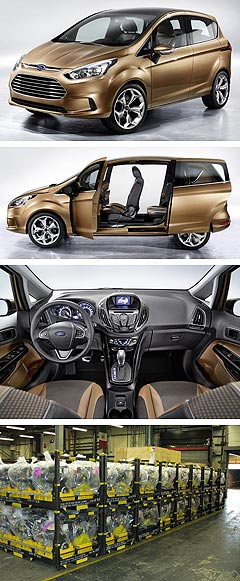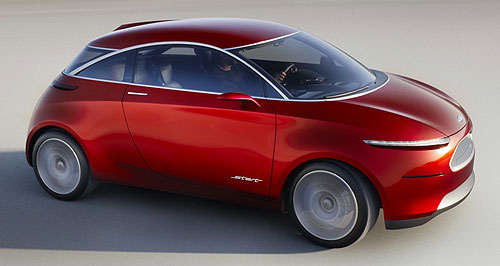News - FordFord prepares three-pot EcoBoost engine for marketStart it up: Ford’s foray into three-cylinder engines was first revealed in April 2010 when it unveiled its Start urban car concept at the Beijing motor show. Ford’s first three-cylinder promises power, economy and low CO2 emissions3 Jun 2011 FORD is set to launch a three-cylinder, 1.0-litre EcoBoost petrol engine for use globally in its light-sized cars like the Fiesta and has announced that it is developing in-house a new eight-speed automatic gearbox plus an electronic continually-variable transmission (CVT) for use in hybrid vehicles. Developed at Dunton in the UK, Ford’s global centre of excellence for small-capacity engines, the turbocharged three-pot is said to deliver performance exceeding that of most naturally-aspirated 1.6-litre four-cylinders while offering significant savings in fuel consumption and CO2 emissions. Ford Australia has denied that the new engine is likely to reach Australian shores any time soon, but if there is any truth in Blue Oval’s bold claims about the downsized engine’s performance, the unit is likely to replace the brand’s larger displacement powerplants in due course. No official performance, fuel or CO2 figures for Ford’s first triple-cylinder engine are yet available as “final calibrations are under way”. Ford group vice president of global product development Derrick Kuzak said that the unit will offer “hybrid-like fuel economy” at an “affordable” price and that in terms of performance the engine is “a little dynamo”.  Left: Ford B-Max. Below: EcoBoost engines ready for shipment. Left: Ford B-Max. Below: EcoBoost engines ready for shipment.Consisting of a cast-iron block featuring an offset crankshaft and a one-piece cylinder head with integrated exhaust manifold, the diminutive donk uses a split cooling system to speed up warm-up times and is designed to reduce the start-up friction of moving parts. Having the exhaust manifold integrated with the cylinder head is said to reduce weight, allow the engine to run more smoothly and lower the temperature of exhaust gases – which enables the engine to run with the optimum fuel/air ratio over a wider rev range. Direct fuel injection, turbocharging and Ford’s twin independent variable camshaft timing form the EcoBoost icing on the cake and Ford vice president of global powertrain engineering Joe Bakaj said that the new technologies developed for this engine could one day be “part of the DNA of future Ford engines”. Ford’s foray into three-cylinder engines was first revealed in April 2010 when it unveiled its Start urban car concept at the Beijing motor show, where Ford revealed the unit to have a 10:1 compression ratio and expected to produce CO2 emissions of less than 100 grams per kilometre. The engine was seen again at this year’s Geneva show in Ford’s Fiesta-based B-Max people mover. The brand is promising to share more “technical and application details” at September’s Frankfurt motor show. The 2.0-litre Mondeo EcoBoost has just arrived in Australia and a similarly-engined Falcon is – after a long wait – due early next year. Australian-delivered examples of the new Focus, arriving in August, will not receive the 1.6-litre EcoBoost engine that features in European cars. A 3.5-litre V6 EcoBoost engine is available on the US market and powers the all-wheel-drive Taurus that is expected to eventually replace the Australian Falcon. “With our global family of EcoBoost engines, we’ve replaced V8s with V6s and V6s with four-cylinders – with no loss of performance and with impressive fuel economy improvements,” said Mr Kuzak. Bavarian luxury brand BMW is also set to debut a high-tech, high specific-output three-cylinder engine – displacing 1.5 litres – in its F20 1 Series and in 2010 PSA Peugeot Citroen also announced that it was working on a turbo triple. Nissan and Suzuki both have three-pot-powered cars on the Australian market in the shape of the Micra and Alto. Ford’s in-house transmission development of an eight-speed automatic transmission is also pressing ahead. The company says the unit, which will feature its next-generation clutch controls, employs a input torque sensor that enables the unit to more quickly select the correct ratio, reducing hunting and resulting in smoother shifts. The Blue Oval is also working on an electronic continuously variable transmission for hybrid vehicles, production of which is due to begin in the first quarter of next year at Ford’s Van Dyke transmission plant in Detroit, a move Ford expects will make it North America’s largest manufacturer of hybrid transmissions. Developed in-house, the transmission is said to offer better performance than the Japanese-built unit used in Ford and Lincoln hybrids like the Fusion sedan, which in current form is capable of reaching 75km/h on electricity alone, with a zero-emissions range of 1.6 kilometres. Ford is planning to release its next generation of petrol-electric vehicles next year, including a plug-in hybrid to do battle with General Motors’ Volt. Ford’s monthly Australian sales have dipped below 7000 units three times this year, the locally-built Falcon recording just 1331 sales in May, a drop of 59.1 per cent while Territory sales plummeted 54.5 per cent to 480 units. Its overall market share year-to-date is nine per cent.  Read more |
Click to shareFord articlesResearch Ford Motor industry news |
















Facebook Twitter Instagram